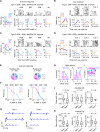Dopamine error signal to actively cope with lack of expected reward
- PMID: 36897945
- PMCID: PMC10005178
- DOI: 10.1126/sciadv.ade5420
Dopamine error signal to actively cope with lack of expected reward
Abstract
To obtain more of a particular uncertain reward, animals must learn to actively overcome the lack of reward and adjust behavior to obtain it again. The neural mechanisms underlying such coping with reward omission remain unclear. Here, we developed a task in rats to monitor active behavioral switch toward the next reward after no reward. We found that some dopamine neurons in the ventral tegmental area exhibited increased responses to unexpected reward omission and decreased responses to unexpected reward, following the opposite responses of the well-known dopamine neurons that signal reward prediction error (RPE). The dopamine increase reflected in the nucleus accumbens correlated with behavioral adjustment to actively overcome unexpected no reward. We propose that these responses signal error to actively cope with lack of expected reward. The dopamine error signal thus cooperates with the RPE signal, enabling adaptive and robust pursuit of uncertain reward to ultimately obtain more reward.
Figures









References
-
- M. E. Bouton, Learning and Behavior: A Contemporary Synthesis (SinauerAssociates Inc., 2007), pp. 346–353.
-
- J. M. Pearce, Animal Learning and Cognition: An Introduction, 3rd ed. (Psychology Press, 2008), pp. 130–134.
-
- V. F. Sheffield, Extinction as a function of partial reinforcement and distribution of practice. J. Exp. Psychol. 39, 511–526 (1949). - PubMed
-
- A. Amsel, Frustration theory: An analysis of dispositional learning and memory (Cambridge University Press, 2010).

